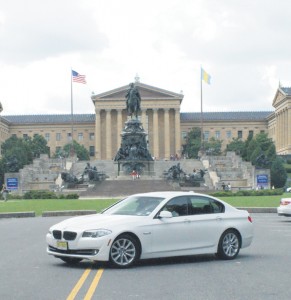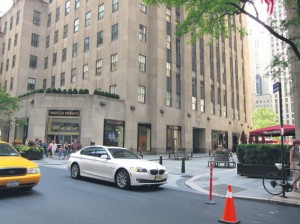BMW 528i makes a thousand-mile journey a thrill

SEEN in the city of brotherly love, the BMW 528i engenders a genuine love of driving, even through a five-hour, nonstop journey.
Driving in the United States is a double-edged sword. On the one hand, you have (mostly) world-class highways, signs in English, and restaurant stops every few miles. On the other hand, those highways are long and monotonous; even lush foliage bordering the road can cease to be amusing after three or so hours. So it was with a mixture of excitement and apprehension when we started our road journey in the United States.
After a 15-hour flight from Hong Kong to New York (19 hours from our first flight out), we arrived, only to begin the second leg of our journey: 438 km over five hours to our final destination in Virginia. We actually felt a bit elated as we saw our ride for the afternoon—a brilliant white BMW 528i—which is a good sign then.
The new-generation 5 Series is a handsome sedan, eschewing the avant-garde but ultimately weird styling cues of its predecessor and instead looking like a future classic. Tapered headlights, smooth profile with nicely creased flanks, and just about perfectly proportioned—it was an invitation to drive if ever there was one. The BMW 5 Series is the perfect choice within the BMW lineup for a multi-state, multi-hour drive. It’s large and comfortable enough for a family of four with their luggage, while being still compact enough for easy maneuverability.
Traditionally, the 528i would be packing a 2.8-liter displacement engine, usually a six-cylinder. But conspicuously new for the 5 Series are four-cylinder engines replacing the inline-sixes. Thanks to twin-scroll turbocharging, direct injection, and variable valve and camshaft timing, the four-pots produce plenty of power. The 2.0 liter in the 528i is good for 245 hp and 350 Nm, more than the six-cylinder. Just a few generations ago, a 2.0-liter pumped up to produce 245 hp would have been a beast of an engine, peaky and needing seconds to respond to throttle inputs while its turbo spools up. Thanks to the miracles of modern electronics and materials, the four-cylinder is as responsive as its large naturally aspirated predecessor. It can go from 0 to 100 kph in 6.3 seconds.
The brawny engine is mated to an eight-speed automatic, through to the rear wheels. We used to do fine with just five or six gears, but in this case more really is better. With the extra-tall gearing in seventh and eighth gears, the 528i can cruise at 104 kph (the speed limit on most US highways) with the engine ticking over at just 1750 rpm. Now, US highway traffic hardly travels at the speed limit, so when keeping up with other traffic at 128 kph, the engine is still at just 2150 rpm. This pays off dividends in fuel economy. The rated fuel economy for the 528i is at 14 km/liter. Over the trip we recorded 11.52 km/liter in mixed city and highway driving. This was better than two other four-cylinder cars we rode in while on this trip: a Honda Accord 2.4 and a Nissan Sentra 2.0 (with a manual transmission at that), both lighter and with substantially less power.
Other fuel-saving technologies lurk under the 528’s hood. The power steering and oil pump are electrically actuated only when needed. Brakes recapture energy and feed it back to the battery. The real show-stopper is literally the Auto Start Stop system. This shuts down the engine when the car is at a full stop-at stop lights, stop signs, stop-and-go traffic-you get the drill. At first the auto shut down brought back memories of flubbing a clutch engagement and having the engine die. But the system immediately fires up the engine the split-second we release the brake pedal. Meanwhile, all the electrics including the air conditioning stay on. A dashboard button can turn off the system if it becomes too obtrusive.
The engine made the miles melt away as fast as our right foot dared, and it was the chassis that made sure we didn’t mind the journey. Finding the ideal driving position was made easy by the fully adjustable driver’s chair, including an extendable seat cushion. The 528’s sculpted rear seats are just as comfortable. All are trimmed in supple Poltrona leather. Nearly all controls were intuitive, including the formerly confounding iDrive system. The electronic gearshift lever, which toggles forward and backward and with a thumb button for park, still takes some getting used to. The navigation system is state-of-the-art, with junction view and 3D buildings within city areas.
The aluminum suspension system, control arms up front and multi-link at the rear, keeps the 5 Series glued to the roads rough and smooth, while shrugging off bumps and potholes. This generation of run-flat tires seems more compliant, too. Steering had just the right balance of effort and feedback. The 5 Series made the miles fly by in a high-speed blur. The five-hour journey actually seemed much quicker than it was. In the true test of a good touring car, we arrived in as good shape as when we stepped into the car. In the days that followed, too, in a journey of over a thousand miles, the 5 proved its mettle as a luxury sedan.
Our two weeks of living with the 5 marked what could have been the beginning of a beautiful friendship. This car qualifies as a finalist in the “what car would you pick if you could have only one for the rest of your life” fantasy-but perhaps we’ll spring for the M version. As it is, the 5 felt at home whether it was jostling with the traffic in Manhattan, driving alongside an Amish buggy in Intercourse, Pennsylvania (the happiest place on earth, perhaps), and parking nose to nose with limousines in Washington, DC.
What makes this generation of 5 a big step forward from its predecessor is that the technology is a genuine enhancement. It no longer gets in the way, like the strange variable-ratio steering of that model. This one feels like a technology-enhanced machine second, driving machine first.

